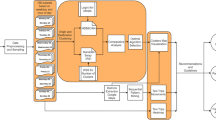Abstract
Detecting spatio-temporal clusters, i.e. clusters of objects similar to each other occurring together across space and time, has important real-world applications such as climate change, drought analysis, detection of outbreak of epidemics (e.g. bird flu), bioterrorist attacks (e.g. anthrax release), and detection of increased military activity. Research in spatio-temporal clustering has focused on grouping individual objects with similar trajectories, detecting moving clusters, or discovering convoys of objects. However, most of these solutions are based on using a piece-meal approach where snapshot clusters are formed at each time stamp and then the series of snapshot clusters are analyzed to discover moving clusters. This approach has two fundamental limitations. First, it is point-based and is not readily applicable to polygonal datasets. Second, its static analysis approach at each time slice is susceptible to inaccurate tracking of dynamic cluster especially when clusters change over both time and space. In this paper we present a spatio-temporal polygonal clustering algorithm known as the Spatio-Temporal Polygonal Clustering (STPC) algorithm. STPC clusters spatial polygons taking into account their spatial and topological properties, treating time as a first-class citizen, and integrating density-based clustering with moving cluster analysis. Our experiments on the drought analysis application, flu spread analysis and crime cluster detection show the validity and robustness of our algorithm in an important geospatial application.


















Similar content being viewed by others
Explore related subjects
Discover the latest articles and news from researchers in related subjects, suggested using machine learning.References
Aamodt G, Samuelsen SO, and Skrondal A (2006) A simulation study of three methods for detecting disease clusters. Int J Health Geogr, 5–15.
Ester M, Kriegel HP, Sander J, and Xu X (1996) A density-based algorithm for discovering clusters in large spatial databases with noise. Second Int Conf Knowl Discov Data Min, 226–231.
Hwang SY, Lee CM, and Lee CH (2008) Discovering moving clusters from spatio-temporal databases. Eighth Int Conf Intell Syst Des Appl, 111–114.
Jeung H, Yiu XZ, Jensen C, Shen H (2008) Discovery of convoys in trajectory databases. Proc VLDB Endow 1:1068–1080
Jeung H, Shen HT, and Zhou X (2008) Convoy queries in spatio-temporal databases. IEEE Int Conf Data Eng, ICDE’08, 1457–1459.
Joshi D, Samal AK, and Soh LK (2009) Density-based clustering of polygons. IEEE Symp Ser Comput Intell Data Min, 171–178.
Joshi D, Samal AK, and Soh LK (2009) A dissimilarity function for clustering geospatial polygons. 17th Int Conf Adv Geogr Inform Syst (ACM SIGSPATIAL GIS 2009), 384–387.
Joshi D, Soh LK, Samal A, Zhang J (2011) A dissimilarity function for geospatial polygons, technical report TR-UNL-CSE-2011-0010. Department of Computer Science and Engineering, University of Nebraska, Lincoln
Kalnis P, Mamoulis N and Bakiras S (2005) On discovering moving clusters in spatio-temporal data. Symp Spatial Temporal Databases, 364–381.
Lai C and Nguyen NT (2004) Predicting density-based spatial clusters over time. In Proc Fourth IEEE Int Conf Data Min.
Neill DB, Moore AW, Sabhnani MR and Daniel K (2005) Detection of emerging space-timeclusters. In Proc 11th ACM SIGKDD Intl Conf on Knowledge Discov Data Min.
Stolorz P et al (1995) Fast spatio-temporal data mining of large geophysical datasets. In Proc First Int Conf Data Min KDD—95, 300–305.
Tobler W (1970) A computer movie simulating urban growth in the Detroit region. Econ Geogr, 234–240.
Yoon H and Shahabi C (2009) Accurate discovery of valid convoys from moving object trajectories. IEEE Int Conf Data Min Workshops, 636–643.
Zhang P, Huang Y, Shekhar S and Kumar V (2003) Exploiting spatial autocorrelation to efficiently process correlation-based similarity queries. In Proc of the 8th Intl Symp on Spatial and Temporal Databases.
Author information
Authors and Affiliations
Corresponding author
Rights and permissions
About this article
Cite this article
Joshi, D., Samal, A. & Soh, LK. Spatio-temporal polygonal clustering with space and time as first-class citizens. Geoinformatica 17, 387–412 (2013). https://doi.org/10.1007/s10707-012-0157-8
Received:
Revised:
Accepted:
Published:
Issue Date:
DOI: https://doi.org/10.1007/s10707-012-0157-8




